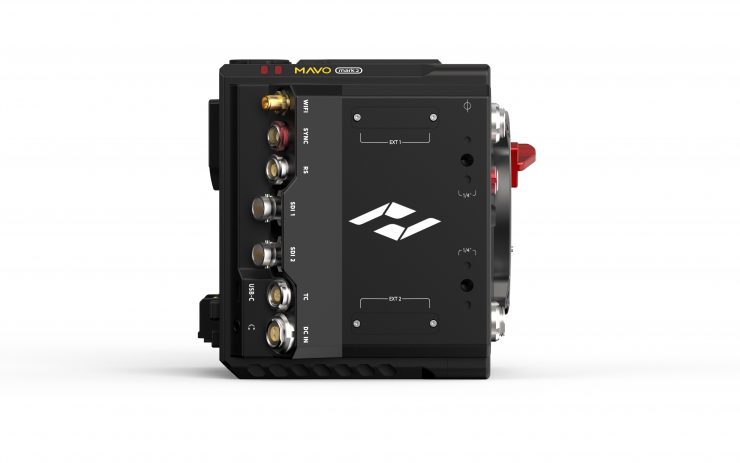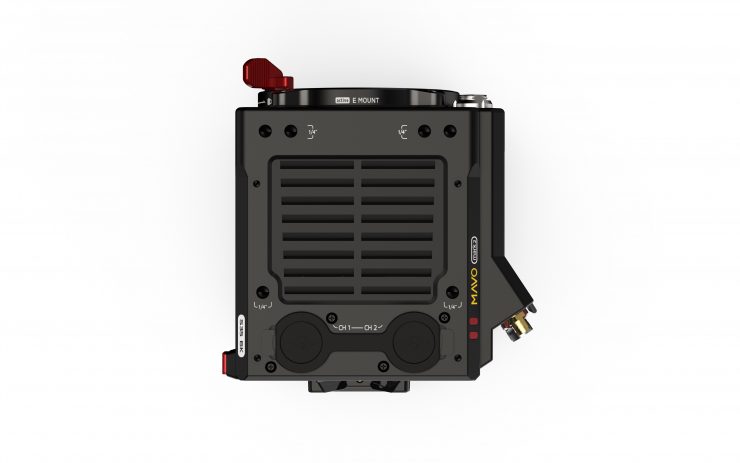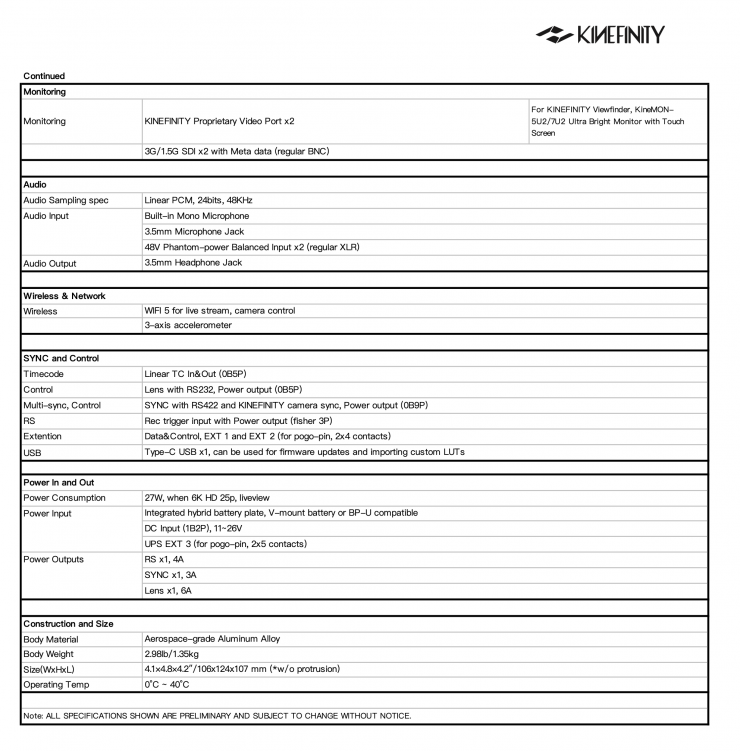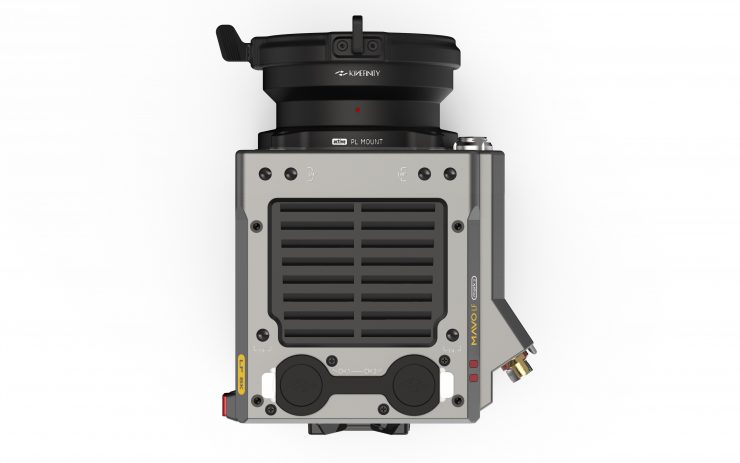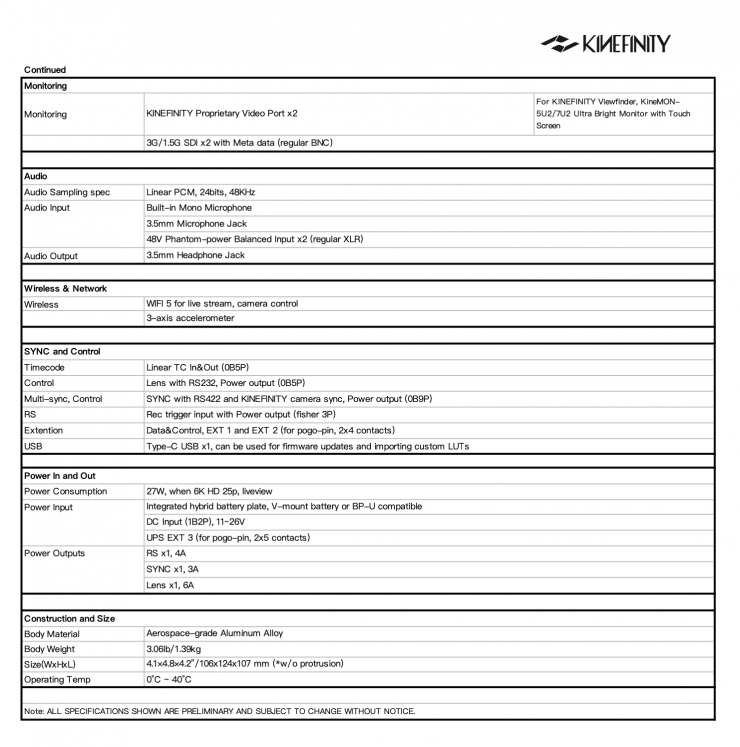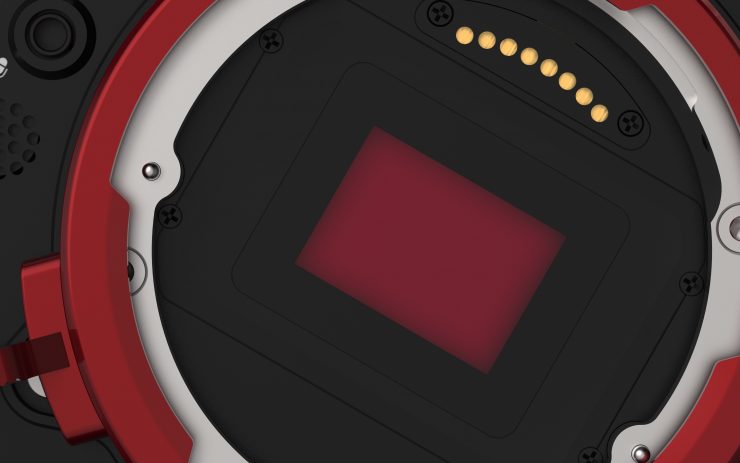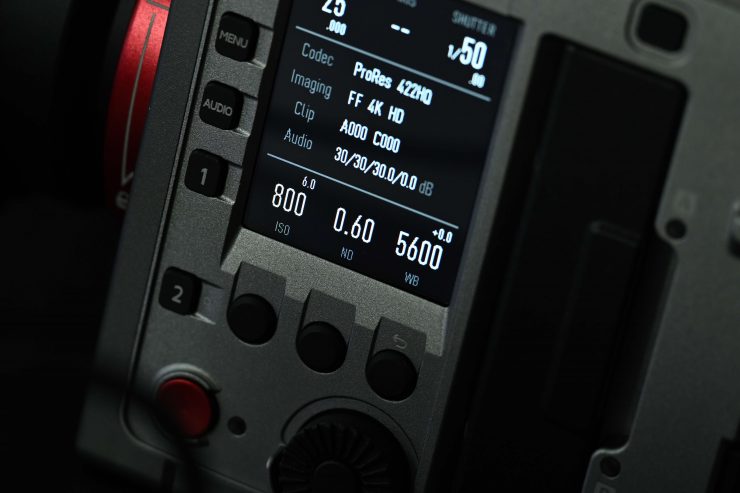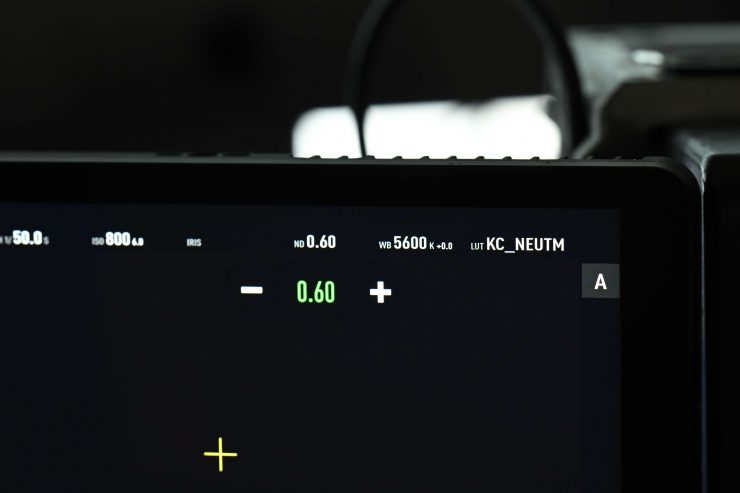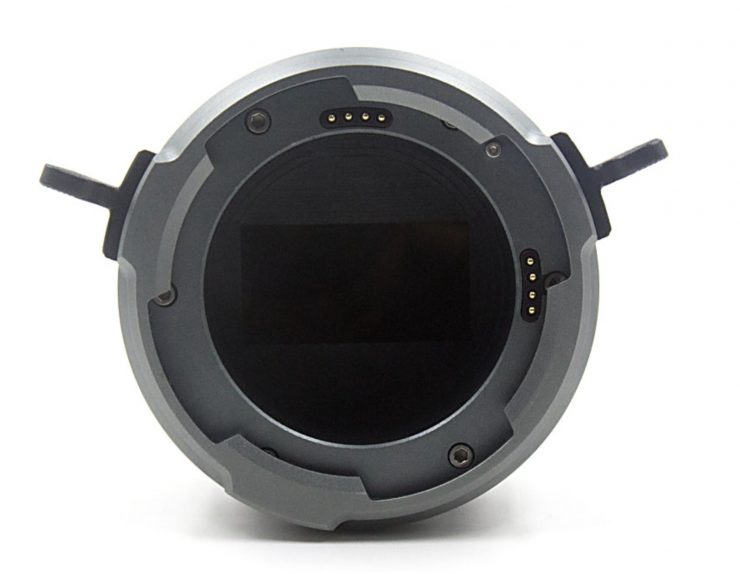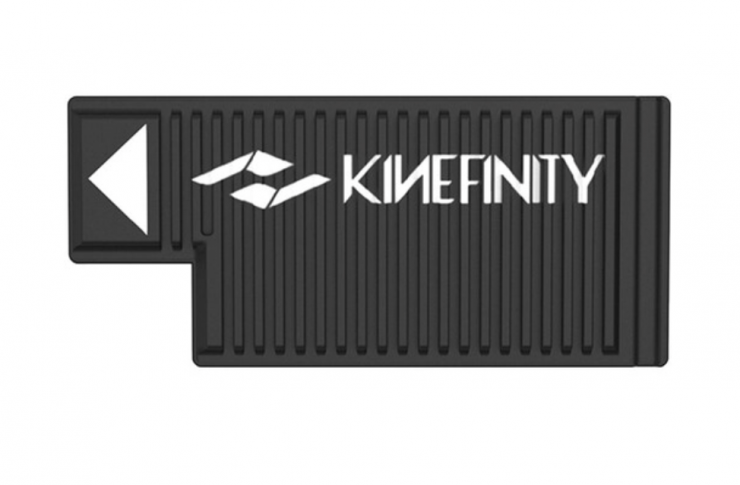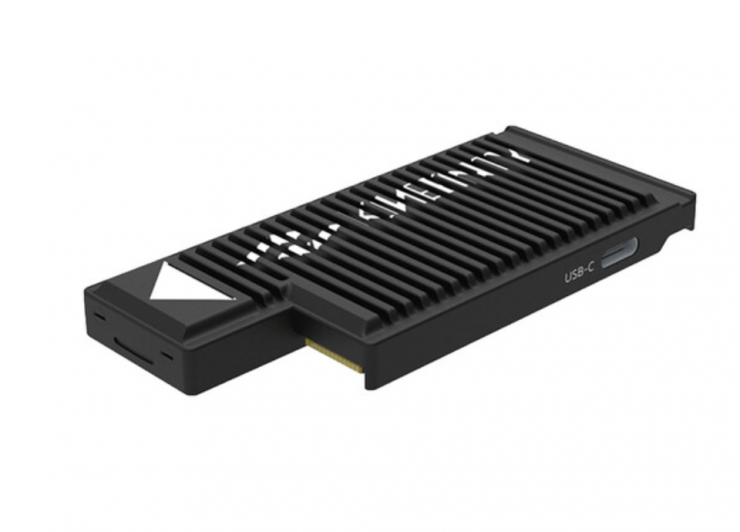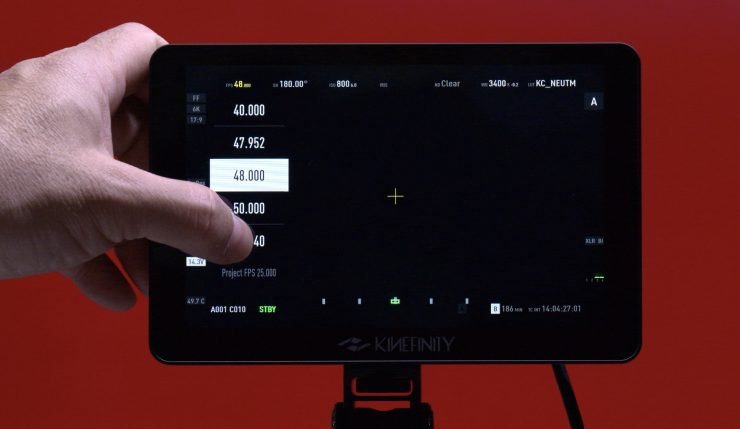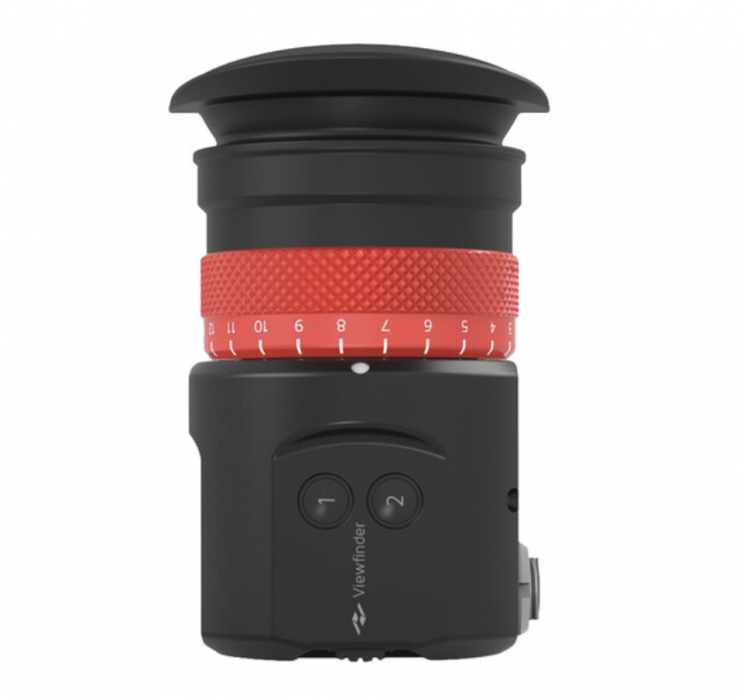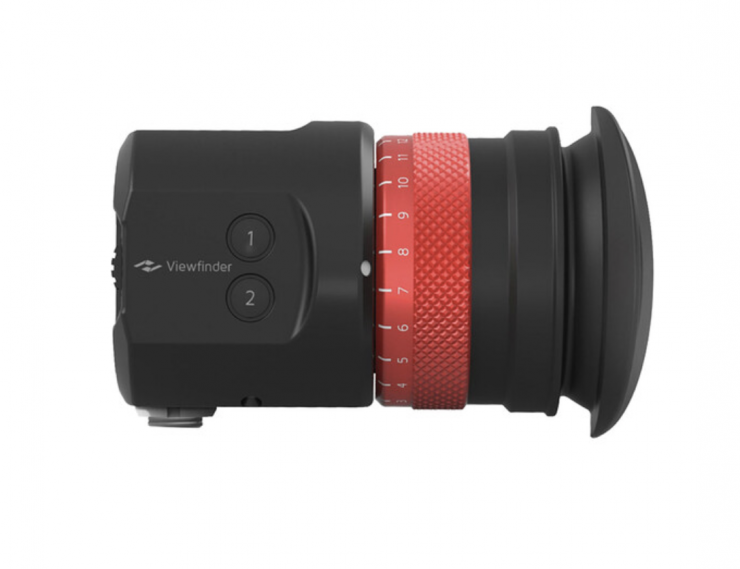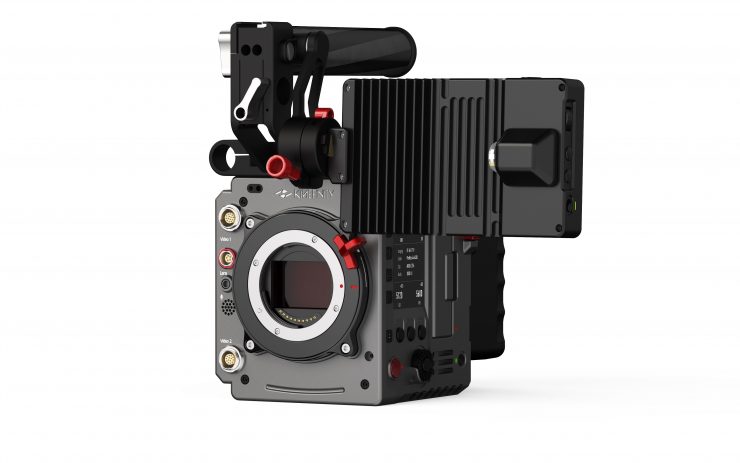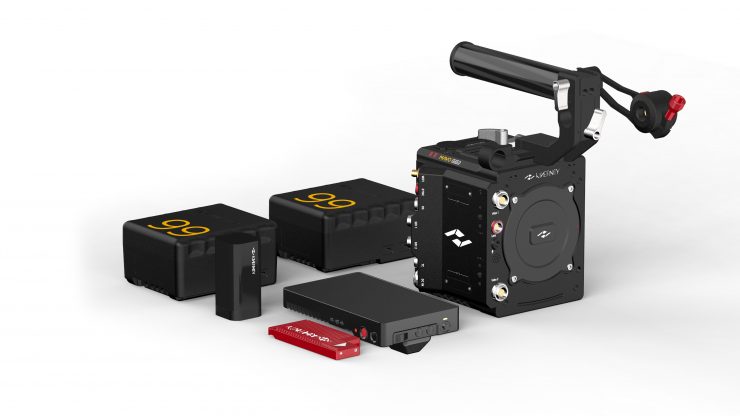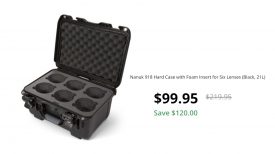
Kinefinity has unveiled its new MAVO S35 Mark 2 and MAVO LF Mark 2 digital cinema cameras. Both cameras adopt the MAVO Edge high-performance computing platform, and they feature integrated industry-standard ports like independent dual SDI outputs with metadata. You can also record Apple ProRes4444/XQ footage onto NVMe M.2 2280 SSD drives.
Most importantly, both cameras have been very aggressively priced.
MAVO S35 Mark 2
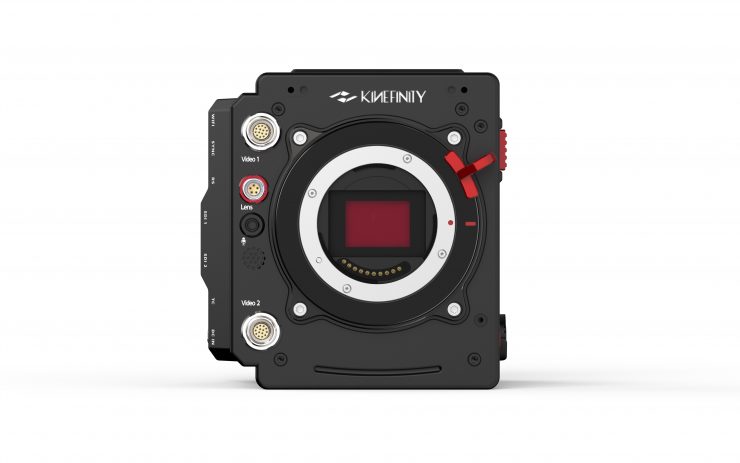
The MAVO S35 Mark 2 features a new 6K S35 CMOS imaging sensor and a dual native ISO of 800/3200. The sensor is also claimed to offer cleaner shadows, better highlight details, and a wide latitude of 14 stops. Kinefinity claims that the camera performs well in low light conditions and that it doesn’t have much noise even at increased ISO settings.
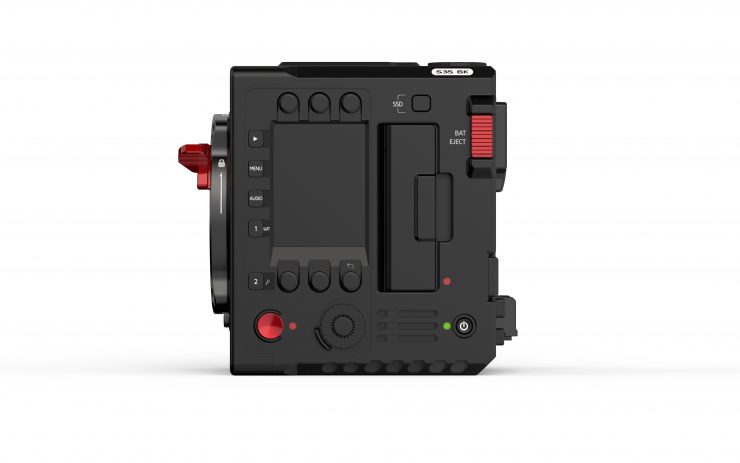
The MAVO S35 Mark II was designed to cater to those users who prefer to shoot in an S35 format than full frame. The benefits of a camera with an S35 sensor are that you can use a wider selection of glass and you can get a longer focal reach. It is interesting to see that as soon as ARRI released a new S35 camera, other manufacturers suddenly designed to do the same thing.
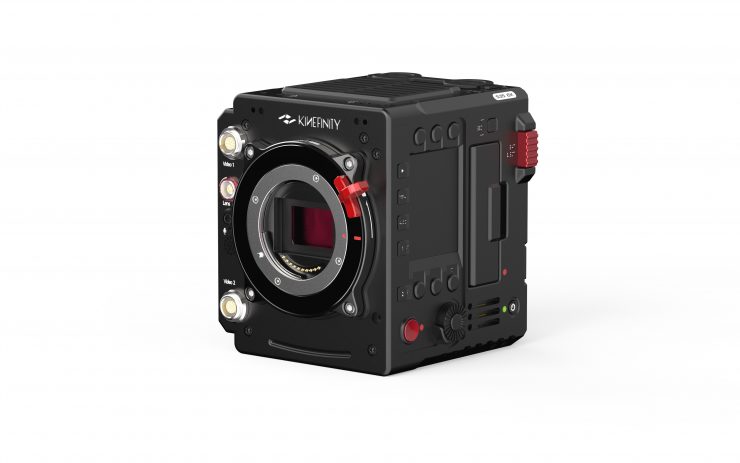
The new S35 3:2 CMOS sensor allows users to capture up to 96fps in 6K Wide (6144 x 2516), and 112fps in 5K Wide (5120 x 2160). In 6K Open Gate (6144 x 4016) you can record up to 60fps. If you want to record above 112fps you need to move to a M43 crop mode where you can record up to 150fps in 3.8K Wide (3840 x 1600). If you drop down to a S16 mode you can record up to 270fps in 1.9K Wide (1920 x 800).
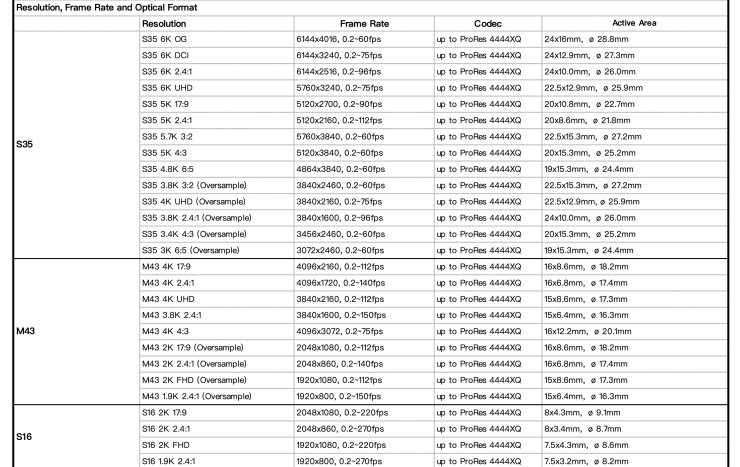
Above you can see the recording options available for the MAVO S35 Mark 2.
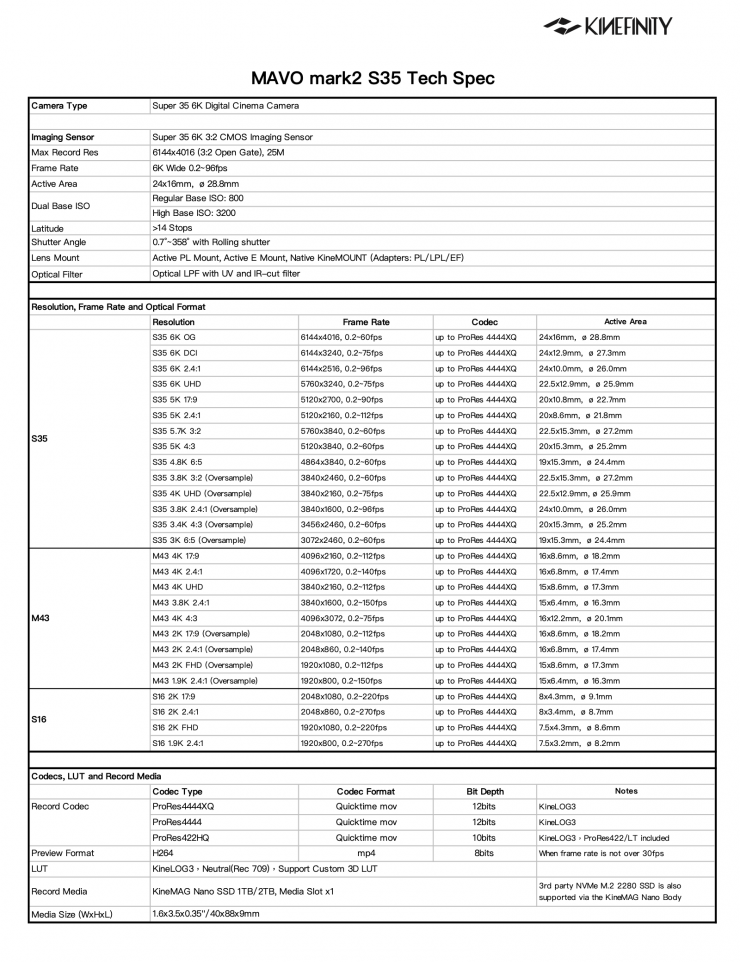
Above you can see the full specifications for the camera.
MAVO LF Mark 2
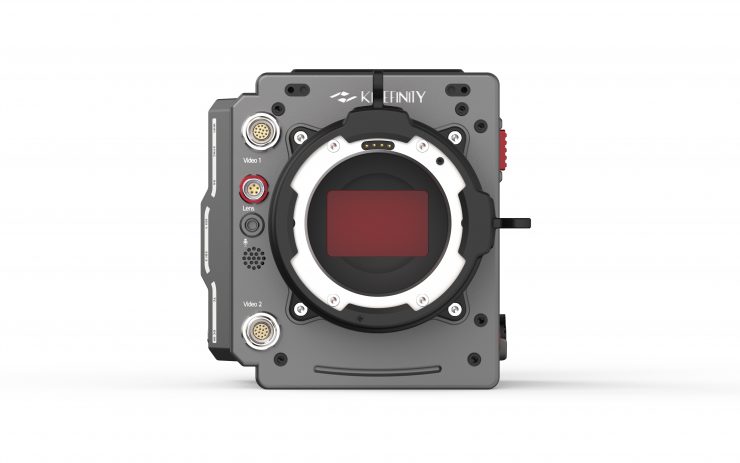
The MAVO LF Mark II uses the exact same full-frame 3:2 CMOS imaging sensor that is found in the MAVO Edge 6K.
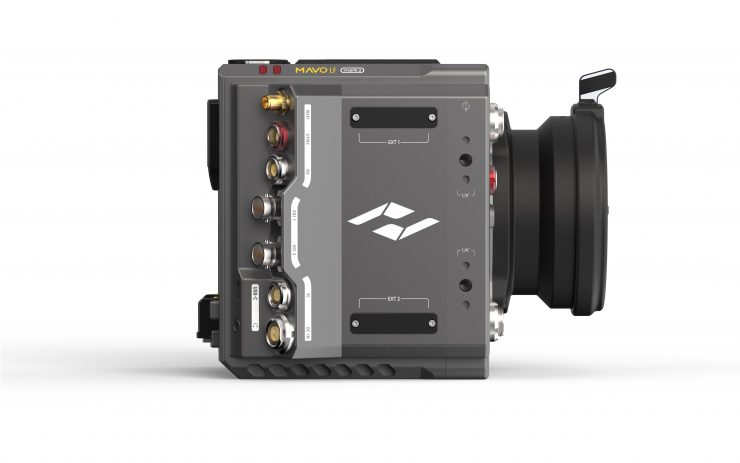
The MAVO LF Mark II has a dual native ISO of 800/5120 and according to Kinefinity, when compared to the MAVO LF, the MAVO LF Mark 2 is capable of retaining more highlight details.
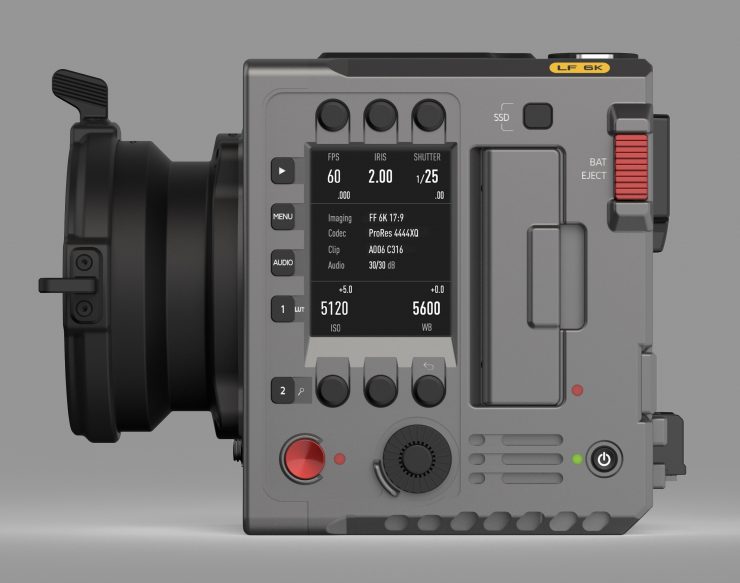
The camera has the same frame rates as the MAVO EDGE 6K so in full frame mode you can shoot at up to 75fps in 5.7K Wide (5760 x 2400), and 86fps in 5K Wide (5120 x 2400). In full frame 6K Open Gate (6016 x 3984) you can record up to 48fps and in 6K 17:9 (6016 x 3172) you can record up to 60fps.
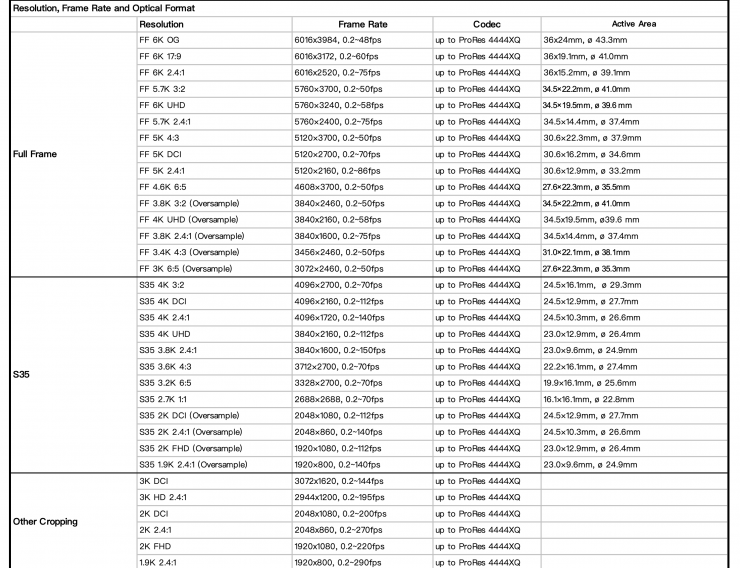
Above you can see the recording options available for the MAVO LF Mark 2. As you can see, if you want to record at higher frame rates above 75fps you need to do so in S35 crop modes.
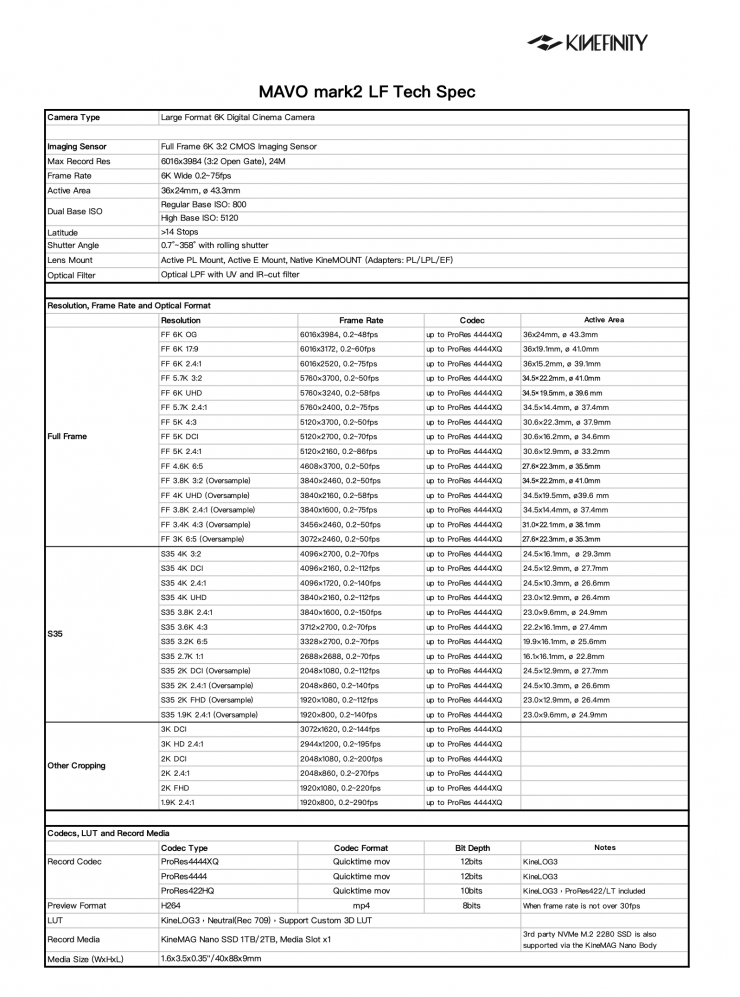
Above you can see the full specifications for the camera.
New Lens Mount Options
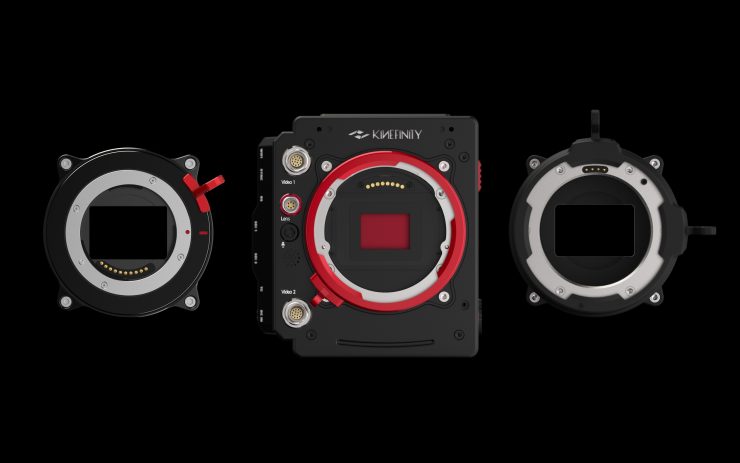
Both of the new cameras allow you to use a more comprehensive range of lenses thanks to the introduction of new mount adapters. While the cameras retain the existing KineMOUNT that allows you to use mount adapters including EF, PL, and LPL adapters without tools, the new cameras can take advantage of two new lens mounts, the Active PL Mount and Active E Mount.
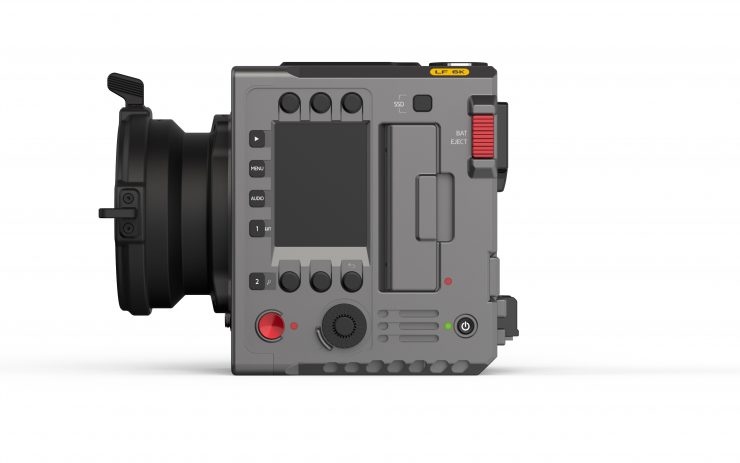
The Active E Mount will support most E-mount lenses. It allows users to adjust the iris, focal length, and focus of these electronic E lenses either via in-camera control or manually. In addition, lens optical stabilization can be activated if the lens has the option. Like the Active PL Mount, the Active E Mount displays lens metadata on monitors and saves them into the clip, so that information can be used in post.
According to Kinefinity users can install and detach the active mounts without the need for additional flange distance calibration. The two active mounts feature a reliable and cine-style locking mechanism.
No Built-in eND
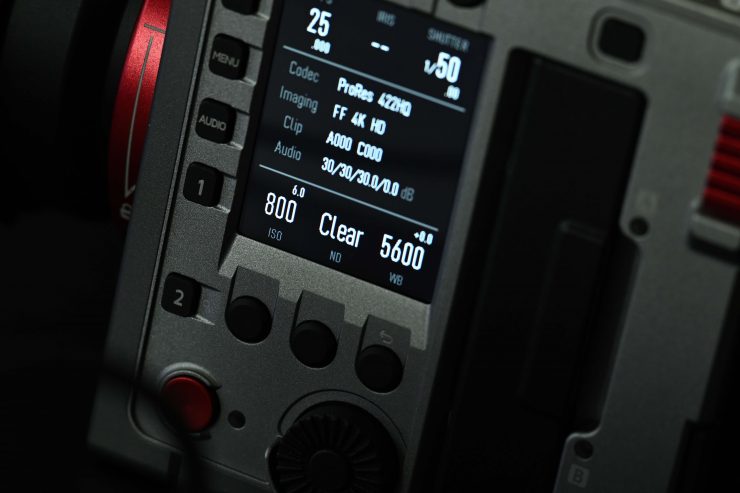
Unlike the MAVO Edge 6K, which features built-in e-ND that can be set to clear or anywhere from 0.6-2.4, the MAVO LF Mark 2 and MAVO S35 Mark don’t have any in-built ND.
If you are wondering why the MAVO LF Mark 2 is a lot cheaper than the MAVO EDGE 6K, this is one of the primary reasons.
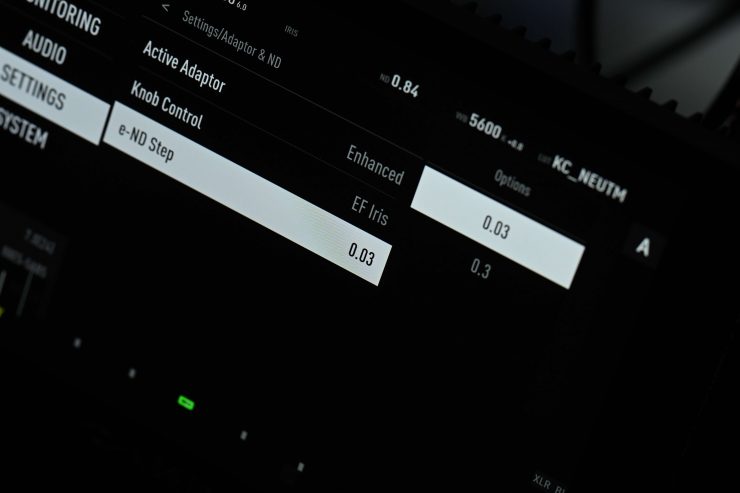
One of the big selling points of the MAVO Edge 6K. was the addition of built-in motorized eND where you can choose to adjust ND in increments of 0.03 or 0.3 stops on the camera body or directly on the KineMon screen.
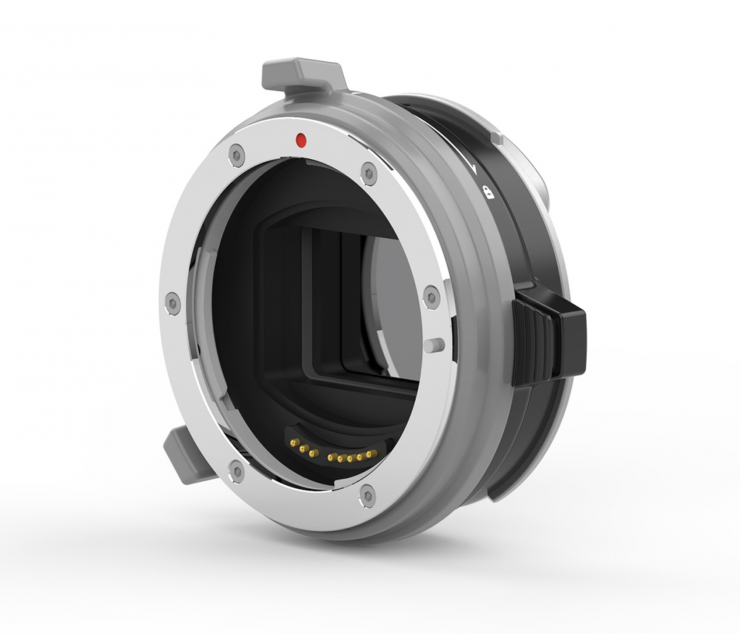
The saving grace for the MAVO LF mark 2 and the MAVO S35 Mark 2 is that Kinefinity does sell two optional e-ND adapters that you can use. You can choose from the EF 3 Mounting Adapter w/ e-ND ($899 USD), or the PL Mounting Adapter w/ e-ND ($999 USD).
These work well, but because they are adapters you always had a minimum of 0.6 dialed in when using them. This meant that you were constantly having to swap the adapter in and out when moving into different lighting conditions.
I am a little puzzled as to why internal eND was left out of these cameras, especially since the new models are primarily based on the MAVO EDGE platform.
Camera Design & weight
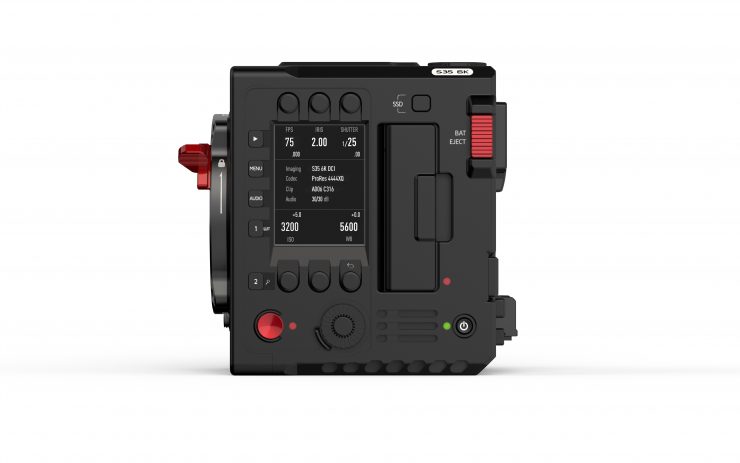
Both the MAVO LF mark II and MAV0 S35 Mark II inherit the same all-in-one box design found in the MAVO Edge cameras. The camera bodies weigh 1.37kg / 3.02lbs, and as I previously mentioned, they are equipped with a host of control ports, dual SDI outputs with embedded metadata and audio, and high-quality multi-channel audio recording capabilities.
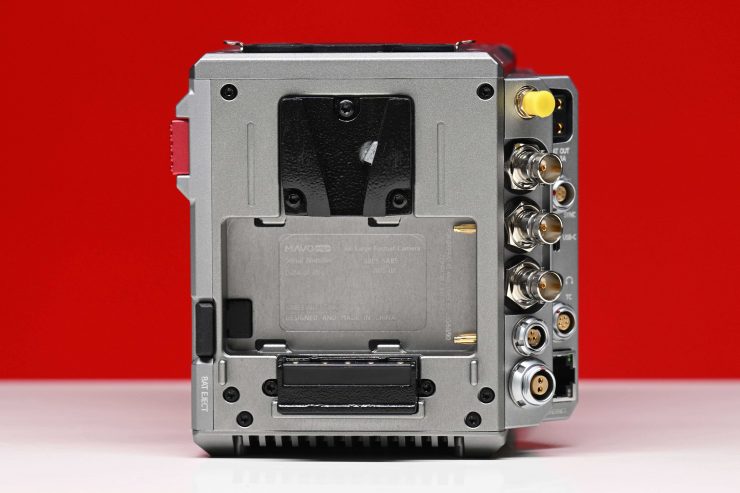

MAVO EDGE 6K 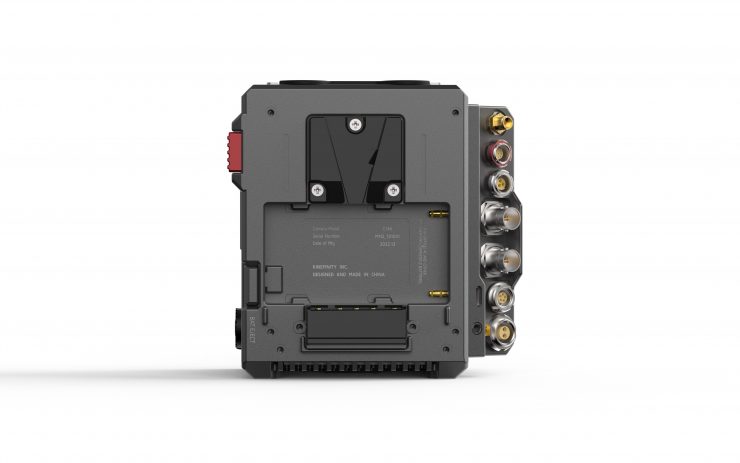
MAVO LF Mark 2 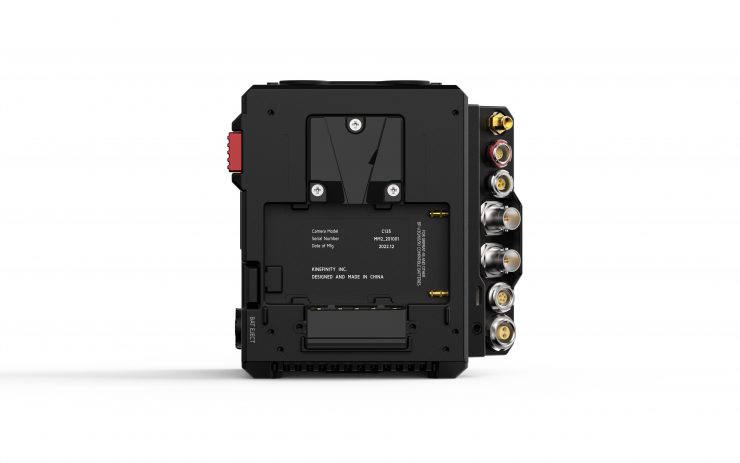
MAVO S35 Mark 2
The MAVO S35 Mark 2 and MAVO LF Mark 2 don’t have the same identical input and outputs as the MAVO EDGE 6K as you can see above.
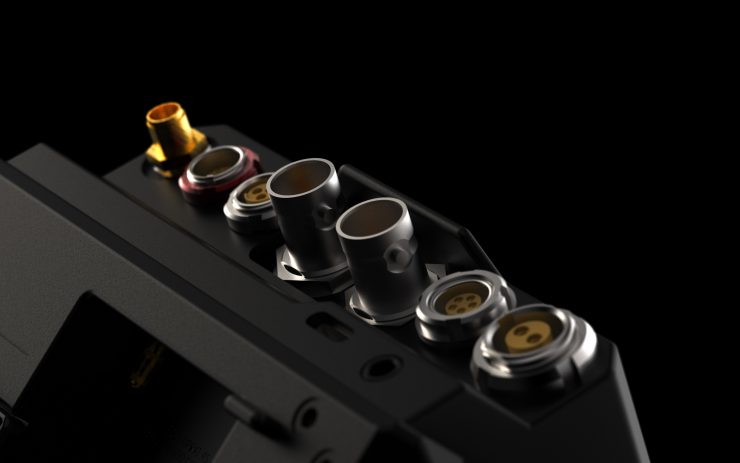
So what are the MAVO Mark 2 cameras missing? Below you can see:
| MAVO EDGE 6K | MAVO S35 Mark 2 | MAVO LF Mark 2 | |
| Video output1.5/3G-SDI | x2 | x2 | x2 |
| Video output SDI TEST | x1 | No | No |
| Phantom 48V power input XLR ports | x2 | x2 | x2 |
| Audio input (3.5mm stereo MIC) | x1 | x1 | x1 |
| Audio output (3.5mm stereo headphone) | x1 | x1 | x1 |
| USB-C port | x1 | x1 | x1 |
| Power output (D-Tap) | x1 | No | No |
| Ethernet (RJ45) port | x1 | No | No |
| 3 pin LEMO DC OUT | x1 | No | No |
| 2 pin LEMO DC IN | x1 | x1 | x1 |
| SYNC port | x1 | x1 | x1 |
| 5 pin LEMO TC Input & Output | x1 | x1 | x1 |
| LENS port | x1 | x1 | x1 |
| Record trigger (RS) | x1 | x1 | x1 |
| Bottom UPS power (EXT3) | x1 | x1 | x1 |
| High speed extension (EXT1&EXT2) | x1 | x1 | x1 |
| Video OUT (for KineMon Monitor and EVF) | x2 | x2 | x2 |
Power

Both MAVO Mark 2 cameras utilize a hybrid battery plate that supports standard 14.8V V-mount batteries and smaller BP-U type batteries. This is a nice option to have because you can choose the type of battery you want to use depending on your requirements.
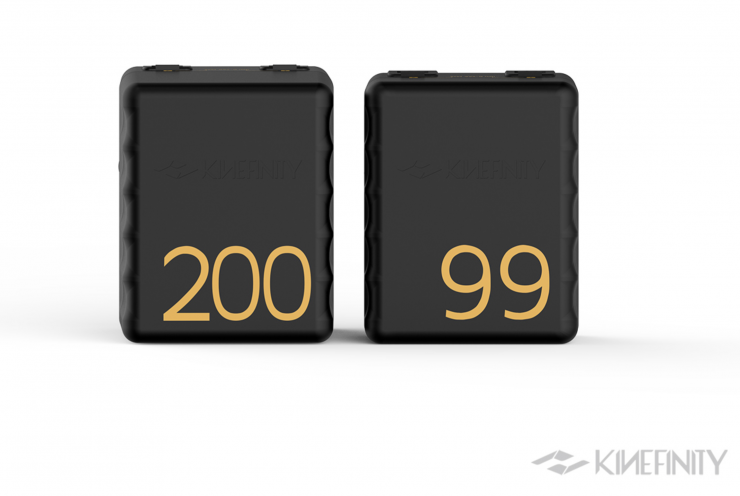
A 200Wh V-mount battery can power the cameras for more than 5 hours.
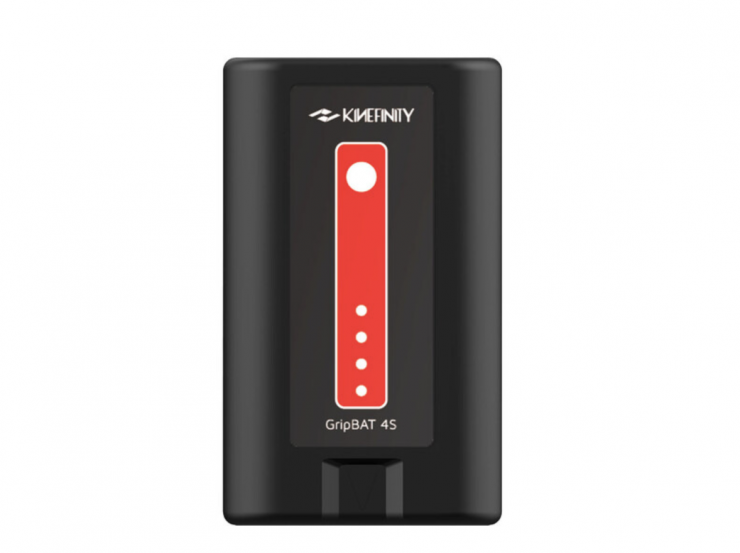
A GripBAT 4S (Compatible with BP-U30) can be installed on the BP-U compartment on the back of MAVO S35 Mark 2 or MAVO LF Mark 2. With a higher capacity of up to 52Wh, the GripBAT 4S still enables a runtime of about 60 mins even when using the KineMON monitor on the camera.
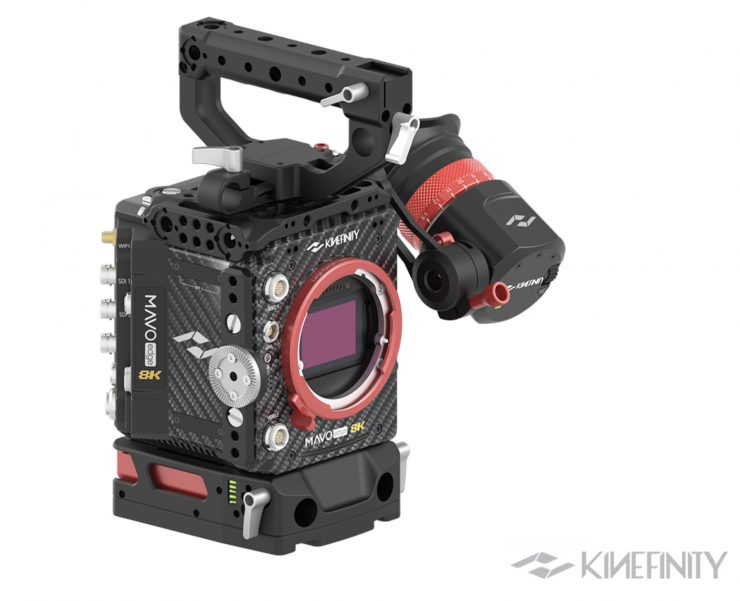
Due to the specialized UPS power contacts at the bottom of the camera, the cameras can also be constantly powered by two NP-F550 batteries with the UPS Baseplate designed by Movcam.
You could also power the camera via the 2-pin push-pull connector to the 2-pin power socket of the camera body.
The great thing about the MAVO Mark 2 cameras is that they only draw 27W. This is very low and allows for long run times on small batteries. What you do need to remember is that the 27W power draw doesn’t take into account the use of the EVF or monitor, or running any +48 audio devices.
If the battery does get very low you will get a warning that comes up on the screen. Both MAVO Mark 2 cameras will then give you a countdown and they will safely shut themselves down. I like that it does this. You can also choose an option where the camera will automatically stop a recording and then shut off if the voltage gets too low.
ProRes Recording
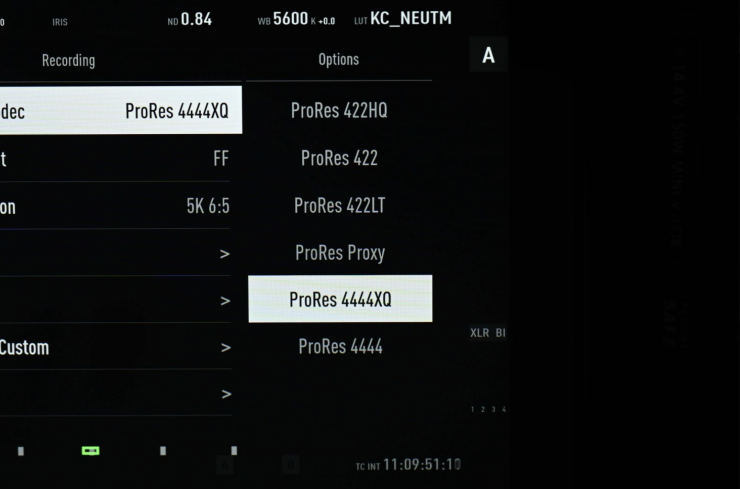
Kinefinity dropped ProRes RAW and KineRaw options from their cameras because of legal issues with RED. Both of the new cameras are capable of recording in flavors of ProRes ranging from ProRes 422 LT up to ProRes4444XQ.
The lack of internal or external RAW recording options does place Kinefinity at somewhat of a disadvantage, as most other competition on the market has the ability to record RAW internally or externally.
Recording Media
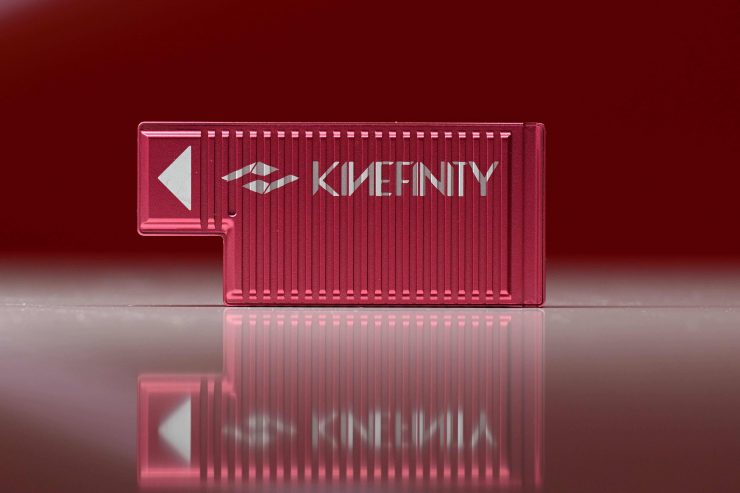
The dual SSD slots on both cameras are based on PCIe-3.0, and the recommended recording media is the proprietary KineMAG Nano 1TB/2TB NVMe M.2 2280 SSD. According to Kinefinity, the KineMAG Nano SSD has two key safety features: Read-only and RAID 5. It is claimed to improve the safeness and robustness of the KineMAG Nano while copying or writing to the SSD at fast speeds in camera. The KineMAG Nano SSDs feature a universal USB-C port, so you can offload data to your computer at a speed of up to 10Gbps with a single USB-C cable.
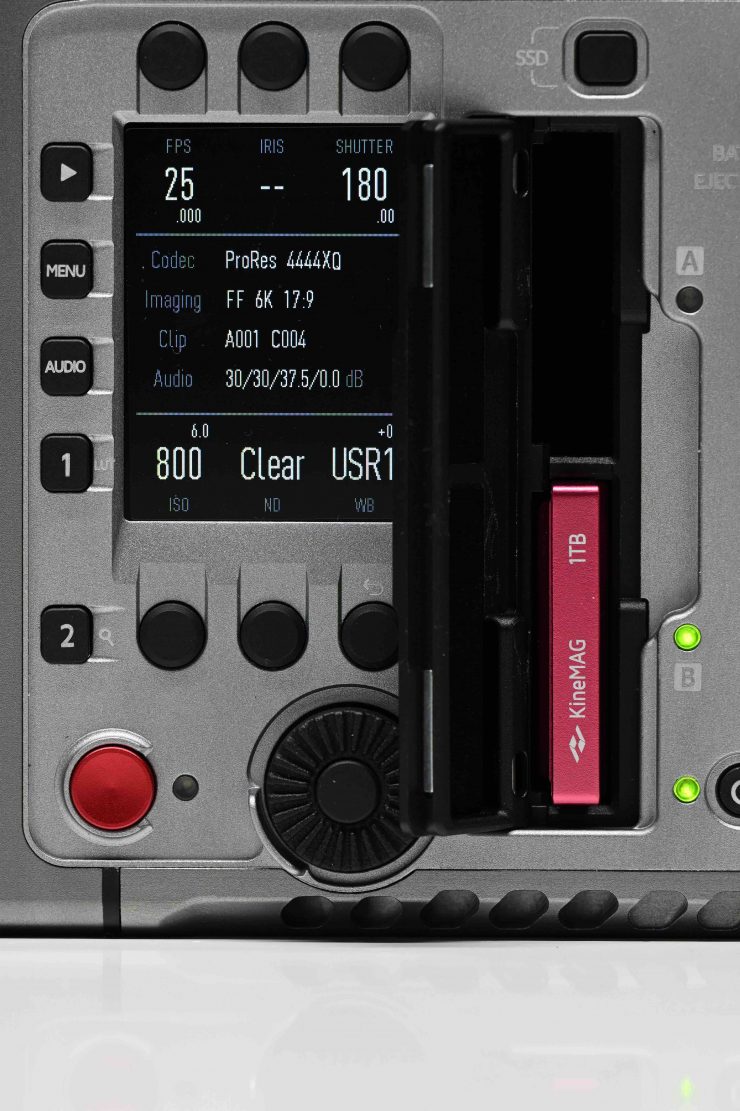
The cameras also have two slots for the KineMAG Nano SSDs.
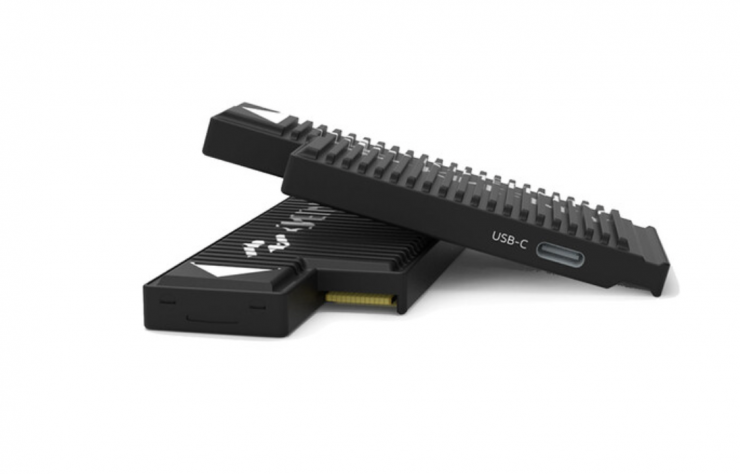
Now, a Kinefinity KineMAG Nano (1TB) retails for $999 USD, but you can also buy a Kinefinity KineMAG Nano Body ($199 USD), which is essentially just an enclosure where you can use your own NVMe M.2 SSD drives.
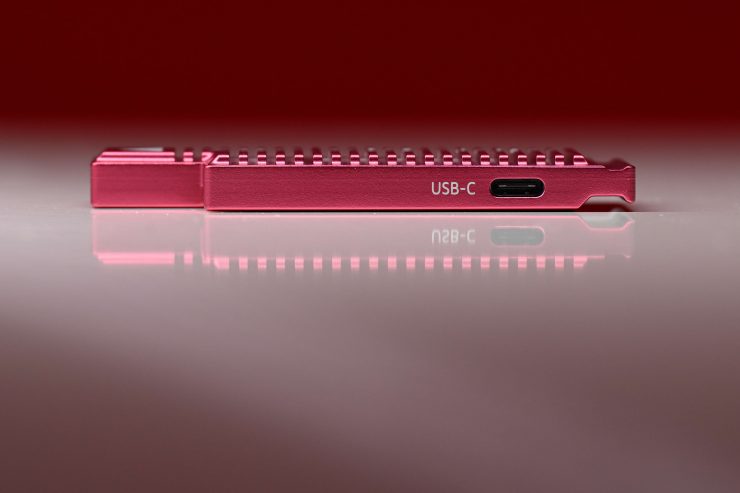
The nice aspect about the Kinefinity KineMAG Nano drives is that you don(t need any type of card reader. They have a built-in USB-C connector so all you need to do is attach a cable to your computer and you offload your material.
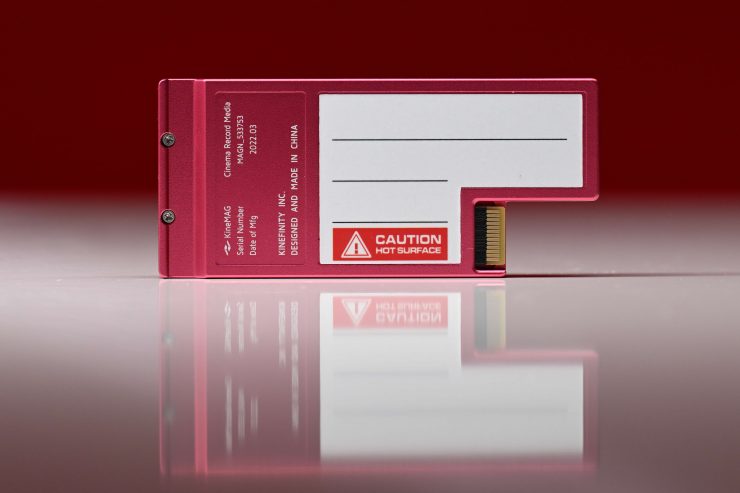
Now, there are some quirks when using these KineMAG Nano drives. If the camera is already turned on and you insert a drive, the camera won’t recognize that drive. You have to have a drive inside the camera before you turn it on.
6K file sizes are going to be enormous in ProRes. Recording 6K 3:2 Open Gate in 25p in ProRes 4444XQ gets you 26 minutes of recording time on a 1TB KineMAG Nano drive. If you record at 48fps (25p project) in the same mode that time drops to just 13 minutes.
If you record 4K UHD at 25p in ProRes 422HQ you can get 232 minutes of recording time on a KineMAG Nano drive.
Accessories
Both MAVO Mark 2 cameras will work with the KineMON-5U2/7U2 touchscreen monitors. All parameters of the camera can be displayed and adjusted on the monitor. The cameras can also be used with the KineEVF2 OLED Viewfinder.
Kinefinity’s 7” field monitor called the KineMON-7U is a good option if you plan on purchasing a MAVO S35 Mark 2 or MAVO LF Mark 2.
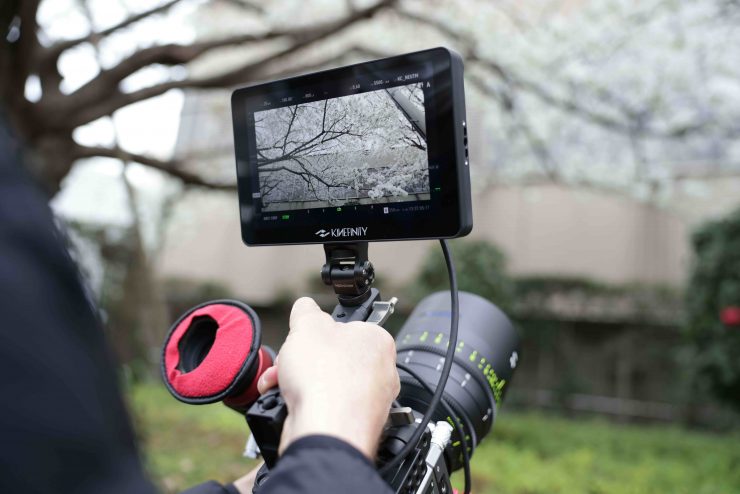
The Kinefinity KineMON 7U Monitor Package ($999 USD) is a 1080p full-HD high-bright 7″ monitor that has a claimed brightness of 2000nit. Only one Kine video cord is needed for the monitor to get power and a video signal from the MAVO cameras.
The screen has 325ppi, a 1000:1 contrast ratio, a good full viewing angle, and LED back-illumination.
KineMON-7U has a standard 1/4″ threaded hole and two pin-holes at the bottom to fasten itself to the camera.
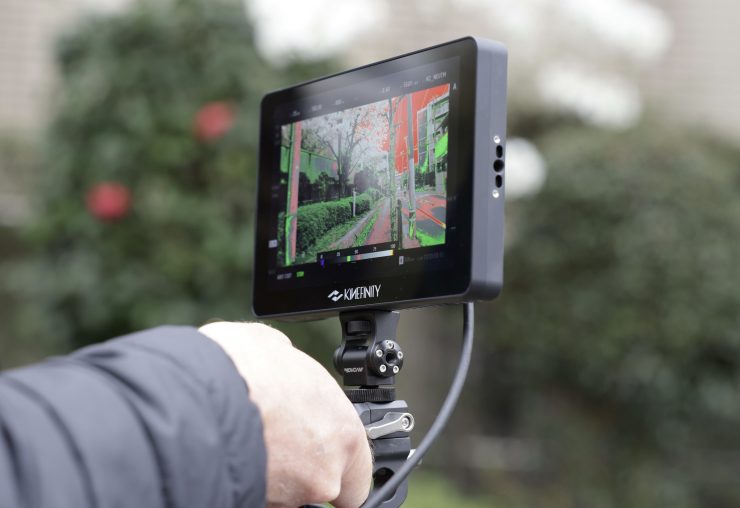
As the monitor gets its power and video signal through a single cable the monitor is always displaying whatever you have up on the camera. There is the ability to activate focus magnification, peaking, false color, a waveform, and a histogram. You also have the ability to adjust the brightness and rotate the image.
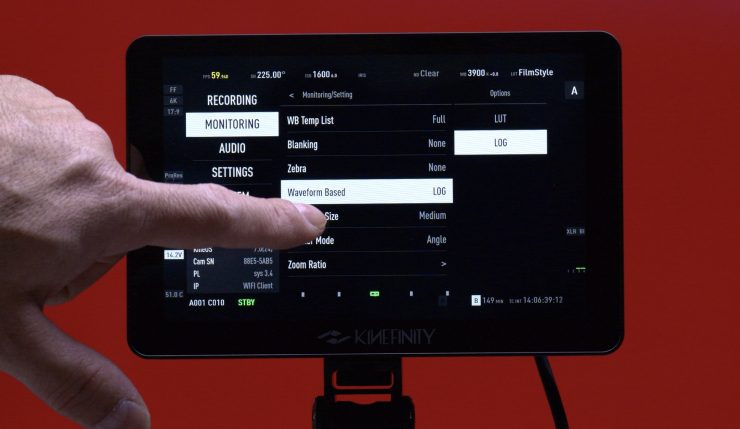
The monitor is nice because it allows you to have complete control and make adjustments to the camera via the touchscreen interface.
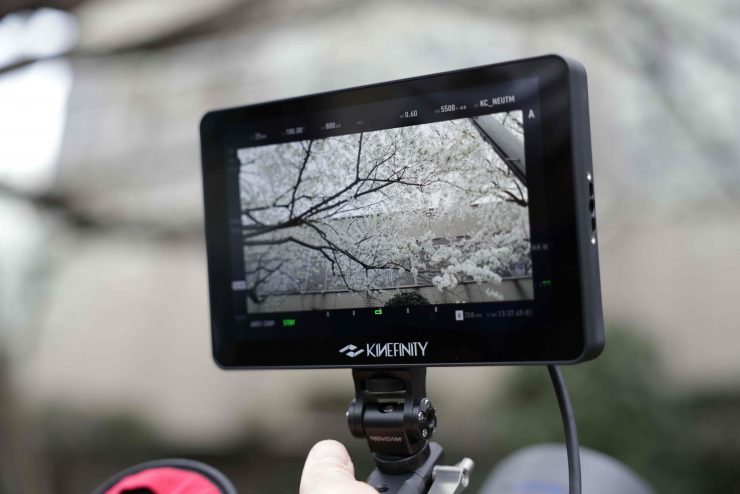
The KineMON-7U is a really nice monitor. It is bright, displays a nice image, and it allows for full control of your camera.
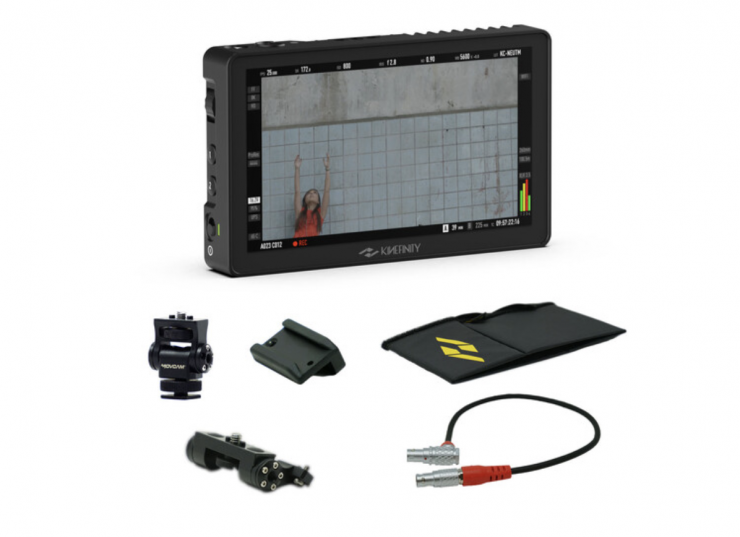
Some users may prefer the smaller-sized KineMON-5U ($769 USD).
KineEVF
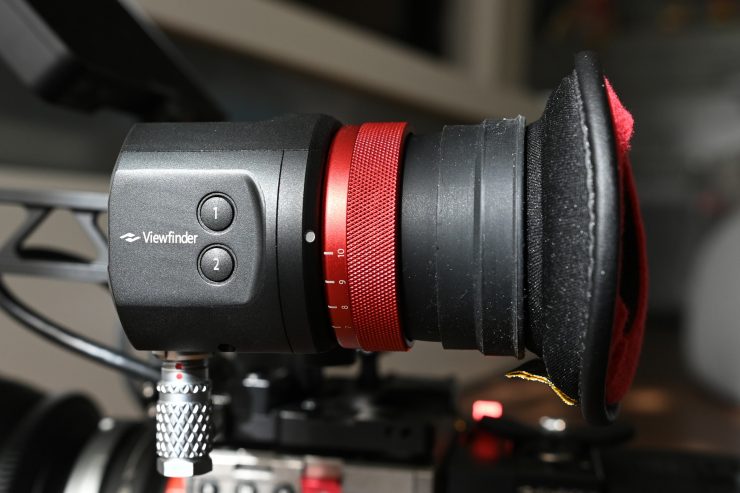
Kinefinty’s proprietary EVF is called the KineEVF ($2,049 USD).
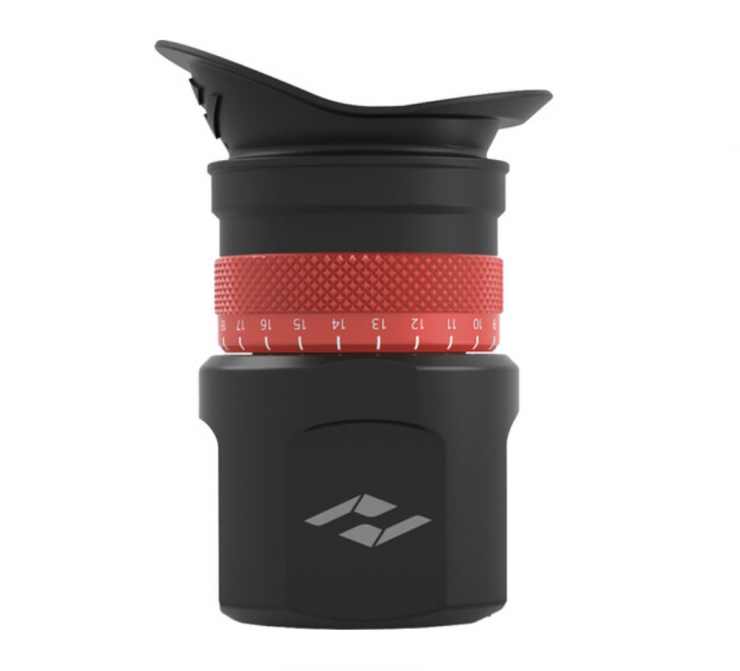
The viewfinder features a micro-OLED 1080p display which Kinefinity claims delivers accurate and sharp picture quality with 16 million colors.
The EVF connects via a single KineMon MOCO cable to deliver power & video from the camera making it a proprietary EVF, specific to Kinefinity cameras.
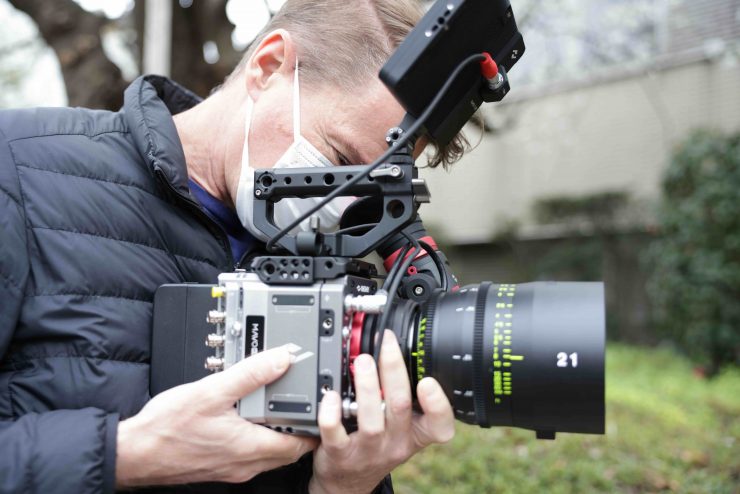
On the MAVO cameras, there is two video out ports for MOCO cables so you can have both the KineEVF and the KineMON-7U connected at the same time.
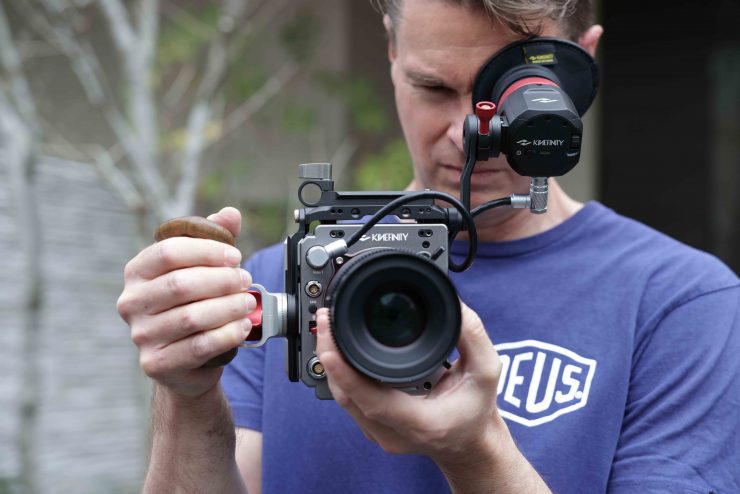
I really like the KineEVF, for its price, it is probably one of the better EVFs I have come across in recent years. It is sharp, bright and displays nice colors. It is also incredibly small and compact. It only weighs 290g. The design really suits the camera.
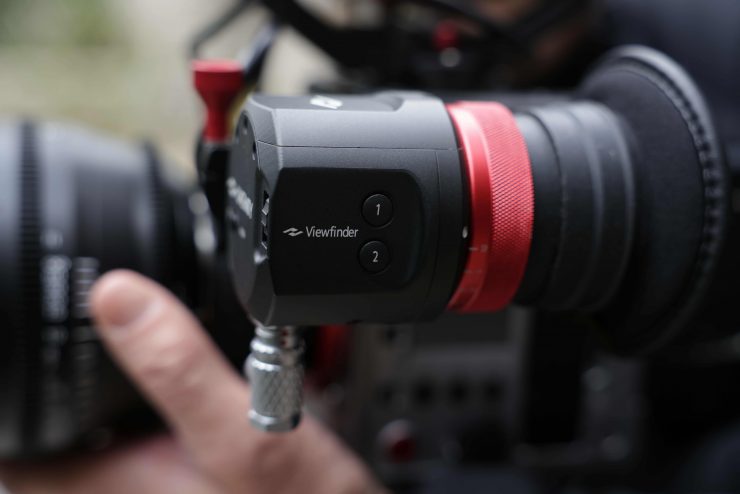
The only downside to the EVF is that there isn’t much in the way of monitoring tools. There is only an ON/OFF switch, a scroll wheel, and two buttons on the side of the EVF.
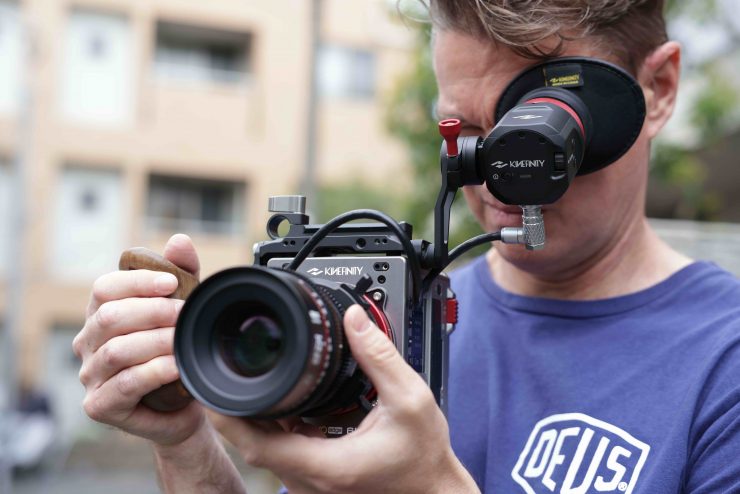
You can change the brightness from Standard to High and you can activate peaking and a histogram, but that is it. As the EVF is getting its power and video signal through the MOCO cable any menu you bring up, or change you make, such as focus punch in, gets reflected in the EVF.
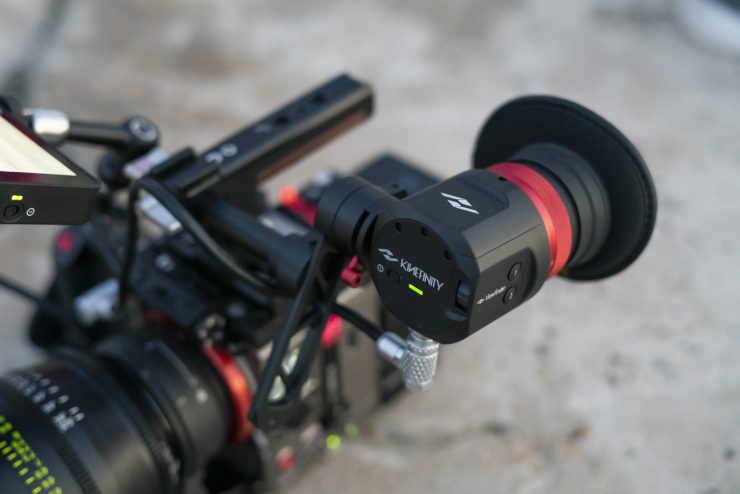
While a lot of people won’t like the fact that the EVF is proprietary most other EVFs from companies such as ARRI, Canon, and RED are also proprietary.
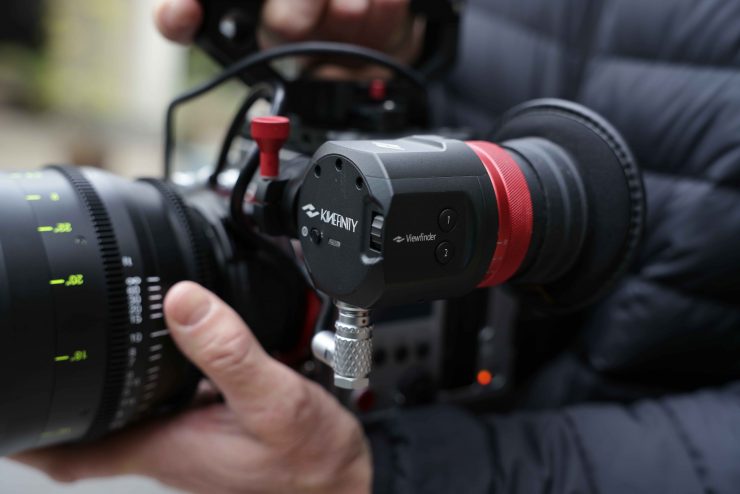
As for mounting, there aren’t any 1/4″ or 3/8″ mounting points. It has been designed to specifically work with the Movcam EVF bracket.
Kits
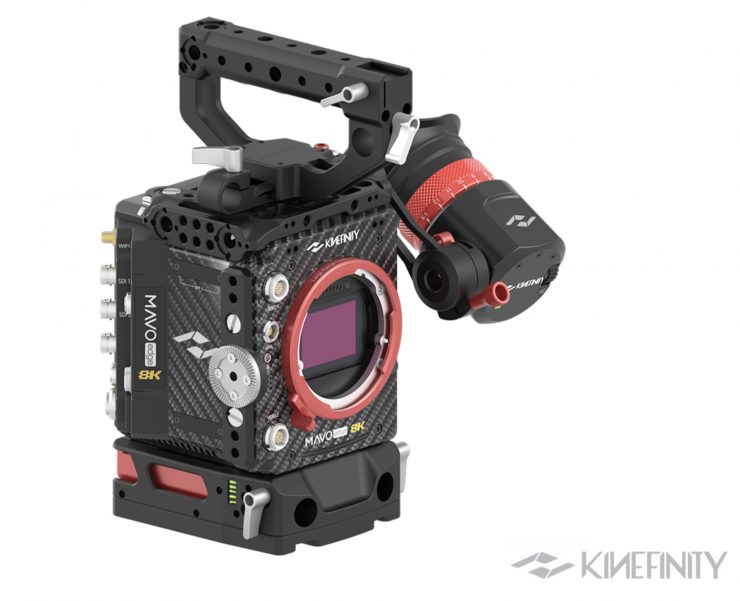
As far as cages and kits are concerned, the MAVO Mark 2 cameras can be used with the Movcam KineKIT-Edge with UPS baseplate, Tilta Camera Cage for MAVO Edge, and SmallRig Camera Cage Kit for MAVO Edge.
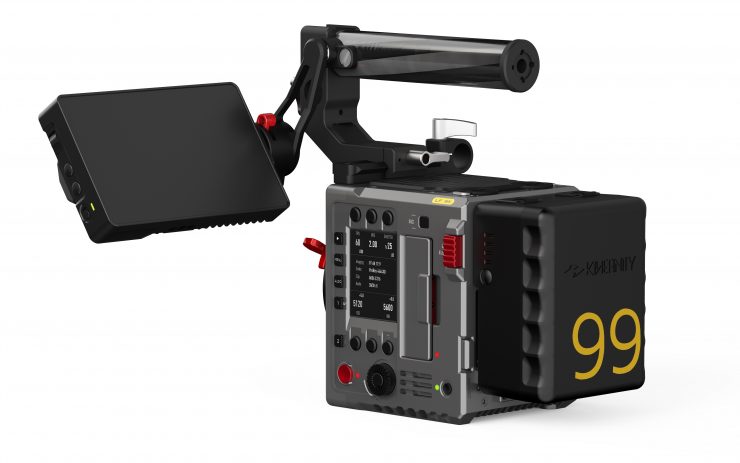
Kinefinity also has a new Agile KIT that features a new carbon fiber top handle, a 2000nits KineMON-5U2 that can rotate 360 degrees, a set of new dual-D and dual-C KineBAT99 batteries, and a KineMAG Nano 1TB SSD.
Pricing & Availability
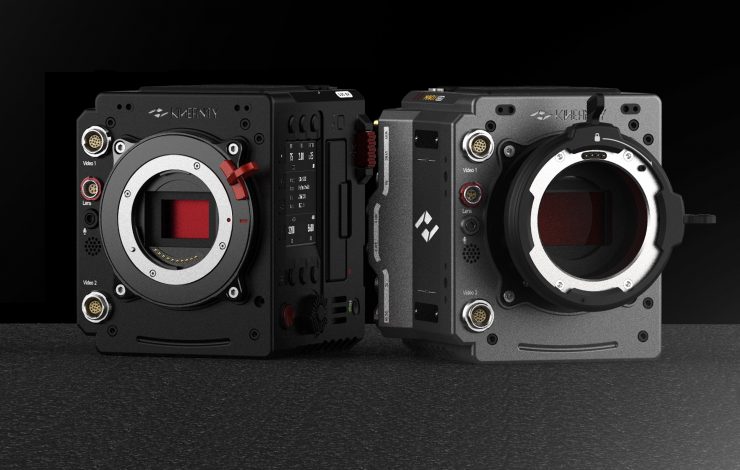
The MAVO S35 Mark II retails for $3,999 USD and the MAVO LF Mark 2 is $5,999 USD. Both cameras are available to preorder starting today at www.kinefinity.com and authorized dealers. The cameras are expected to start shipping at the start of March.
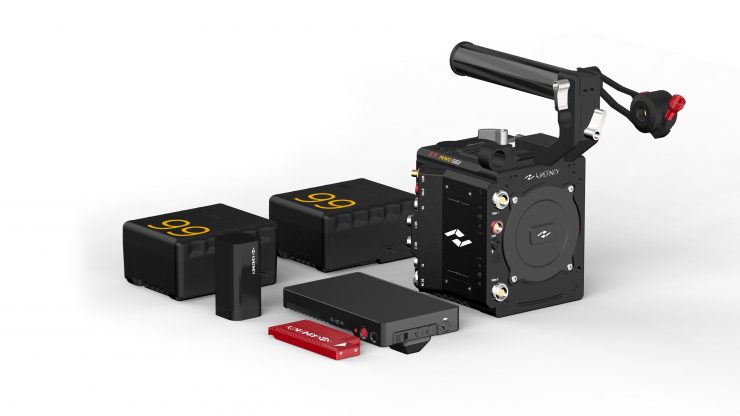
The MAVO S35 Mark II Agile Pack is $6,200 USD and the MAVO LF Mark 2 Agile Pack is $8,299 USD.
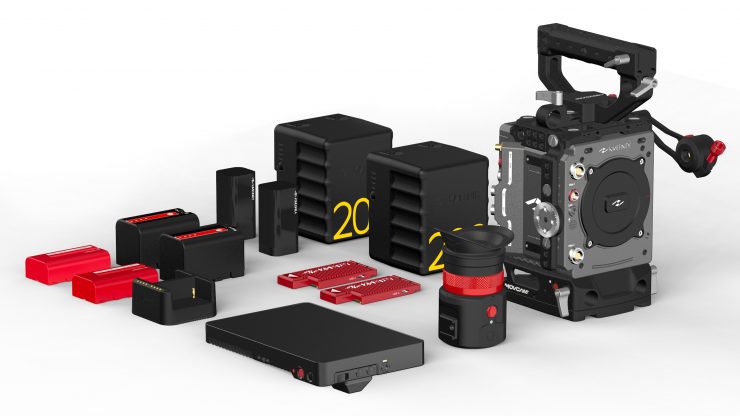
There will also be a Pro Pack available.
Kinefinity is offering a free Active E-Mount when you purchase either camera during the preorder.
You might be thinking, where does this leave the MAVO EDGE 6K? The MAVO LF Mark 2 offers a lot of the same functionality and features for almost 40% of the cost, however, it doesn’t come with built-in eND.
Competition
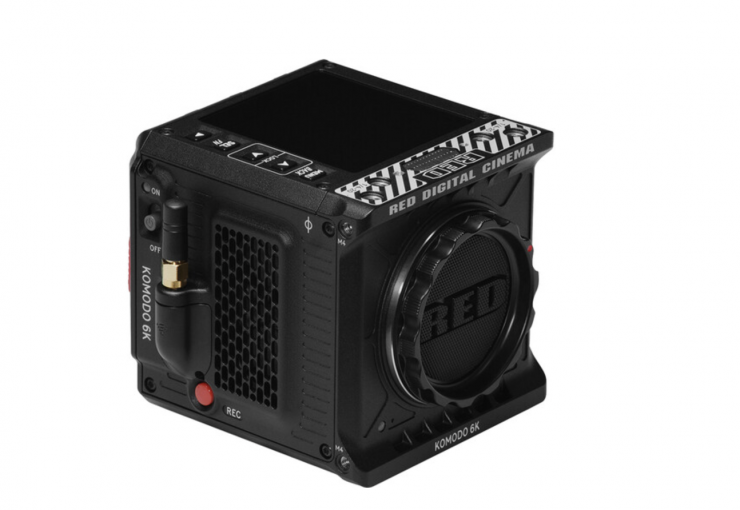
The MAVO S35 Mark 2 and MAVO LF Mark 2 face stiff competition and I have listed the prices of other competing cameras below.
| PRICE | |
| MAVO S35 Mark 2 | $3,999 USD |
| MAVO LF Mark II | $5,999 USD |
| MAVO EDGE 6K | $8,799 USD |
| RED KOMODO | $5,995 USD |
| Sony FX6 | $5,999 USD |
| Sony FX9 | $10,999 USD |
| Canon C70 | $5,499 USD |
| Canon C300 Mark III | $10,999 USD |
| Blackmagic Design URSA Mini Pro 4.6K G2 | $5,995 USD |
| Blackmagic Design URSA Mini Pro 12K | $6,385 USD |
| Z CAM E2-F6 | $2,999 USD |
| Z CAM E2-S6 | $2,199 USD |
| Z CAM E2-S6G S35 6K | $5,995 USD |
| Z CAM E2-F8 Full-Frame 8K | $5,995 USD |
As you can see, the MAVO LF Mark 2 and MAVO S35 Mark II are both competitively priced compared to the competition. The MAVO S35 Mark 2 in particular looks to offer very good functionality and features for a digital cinema camera that is under $4,000 USD.
Thoughts
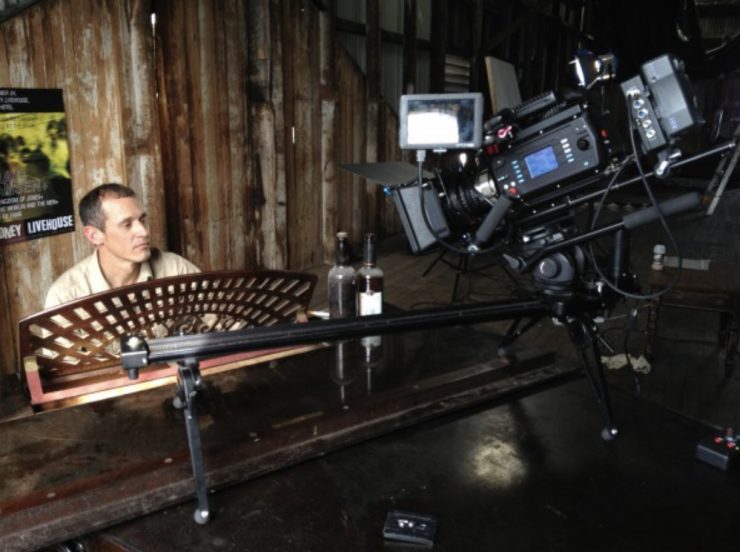
Kinefinity was one of the first market disrupters to make digital cinema cameras. They have occupied a rather niche place in the digital cinema camera space, and even though they are a small company they have now been around for 11 years. I actually shot with their first-ever prototype camera, the KineRAW S35 way back in 2012.
The company has come a long way since 2012 and its cameras have continued to get better and better over the years. The last Kinefinity camera I reviewed was the MAVO EDGE 6K, and that was a very capable camera given its capabilities and feature set. Kinefinity has now reached a point where they are arguably no longer thought of as “That Chinese camera“, but rather, as a legitimate alternative to other more well-known brands. In fact, Kinefinity cameras are now sold through B&H. You should never judge a book by its cover.
Kinefinity continues to get better and better and I am still amazed by how impressive their cameras are given the company is so small. Making a camera, let alone a good one is no easy task. Many have tried and failed.
The biggest problem these days when convincing someone to buy a camera is that almost all of the offerings are very capable of producing nice pictures regardless of the cost. Usability, reliability, brand recognition, after-sales support, and feature set are what now sets the majority of cameras apart.
The other issue Kinefinity faces is that they only released the MAVO EDGE 6K in March last year. Suddenly, that camera which is currently on sale at B&H for $8,799 USD (it was $9,999 USD) appears to be overpriced and anyone who bought one just lost a ton of money if they want to sell it. Potential buyers are not going to have a lot of confidence in buying a Kinefinity camera when a cheaper replacement with an almost identical feature set comes out a year later for a lot less money.
The caveat with buying any product from a small company is that it has to be better than what’s on offer from the big boys. You can’t just make a product that is the same, otherwise, nobody will buy it. Kinefinity has positioned itself as an alternative solution to more popular cameras on the market. However, cameras from mainstream companies have continued to come down in price and there is no doubt that cameras such as the RED KOMODO took away a lot of potential Kinefinity sales.
Previous Kinefinity cameras that were released over the last couple of years were positioned at a price point that arguably put them in no man’s land. The digital cinema market has clearly separated itself over the last 3-4 years into two categories. The majority of cameras are priced below $11,000 USD (with a lot of them actually below $6,000 USD). You then have the higher-end offerings from Sony, RED, and ARRI.
Competing companies to Kinefinity, like Z CAM, have tried to stay in their lane and their most successful cameras are the ones that were all priced under $3,000 USD. Even if you look at Z CAM’s most expensive camera, the Z CAM E2-F8 Full-Frame 8K Cinema Camera, that’s still under $6,000 USD.
Despite the fact that both of the new MAVO Mark 2 offerings look like good cameras, and that the prices of the new cameras are very competitive, it will be a hard sell for Kinefinity to convince people to buy their camera over an FX9, FX6, C300 Mark III, C70, RED KOMODO, etc. In some ways, that is a pity, but that is the reality.
The Kinefinty cameras arguably offer better features and functionality than cameras at a similar price point, but brand recognition tends to come into play that puts Kinefinity at a disadvantage. If you are creating your own content or doing Indie films where the camera brand you are using doesn’t matter, the Kinefinity cameras are a good option. If you are working for clients or shows that are going to ask you what camera you are using (even though sometimes that shouldn’t matter) then they are probably not going to be familiar with Kinefinity. This is something you clearly need to think about if you are considering a Kinefinity camera.
Despite all these caveats that you need to be aware of, it is good to see Kinefinity bring out full-featured cameras at a very affordable price.

